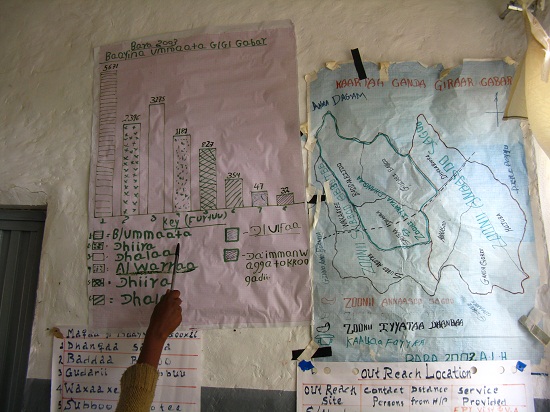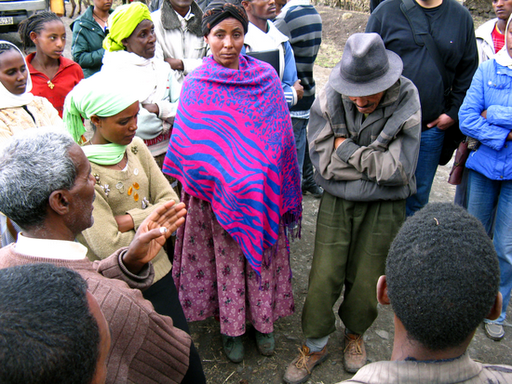-
Integrated Approach Helps “Model Farmers” Increase Productivity in Ethiopia
March 24, 2011 By Schuyler Null
To reach the village of Grar Gaber from Addis Ababa, you drive up over the Entoto Mountains overlooking the capital then motor down two hours of new Japanese-built highway to the town of Fiche. From there it’s 20 minutes on a broken dirt road across rocky hills. I was joined there by about 20 others from the PHE Ethiopia Consortium’s general assembly (see day one and day two coverage here) and Population Action International, to visit an integrated population, health, and environment (PHE) development program run by LEM Ethiopia.
The two-hour trip from the capital gives a first-hand look at Ethiopia’s environmental issues: The land, which has historically been fairly heavily populated by pastoralists and farmers, is noticeably degraded. Bare hillsides are carved by erosion, fields and piles of rock hint at the shallowness of the topsoil, and what little trees remain are non-native eucalyptus, which were introduced in the late 19th century to combat deforestation.
Grar Gaber
In Grar Gaber, home to 5,671 people, LEM Ethiopia has been working for five years to fill in the gaps between the different government health, environment, and agricultural initiatives serving the community, said Executive Director Mogues Worku.
 Bogalech Zawde, one of the village’s health extension workers, showed us the list of more than 950 “model farmers” that have received combined health and agricultural training developed by LEM. In addition to information on child and maternal health, reproductive health, HIV/AIDS, Tuberculosis, and sanitation, the “model farmer” training provides information on optimal seed varieties (often supplied), planting techniques, and land and water management. The farmers are expected to then train their peers and report back to Zawde.
Bogalech Zawde, one of the village’s health extension workers, showed us the list of more than 950 “model farmers” that have received combined health and agricultural training developed by LEM. In addition to information on child and maternal health, reproductive health, HIV/AIDS, Tuberculosis, and sanitation, the “model farmer” training provides information on optimal seed varieties (often supplied), planting techniques, and land and water management. The farmers are expected to then train their peers and report back to Zawde.There are 30,000 health extension workers like Zawde across Ethiopia, averaging two per village, said PHE Ethiopia Consortium Director Negash Teklu. At LEM sites, they get extra help to implement cross-cutting environment and livelihood efforts, in addition to health services. In this way, LEM’s work supports the existing government structure, said Worku.
“What we’re doing is bringing together the health, agriculture, and Environmental Protection Authority workers so we can integrate the various components,” said Teklu, and help the different government ministries communicate more effectively with one another and the community.
“Model” Results
The results were impressive: We visited four households that had received and implemented LEM training. At each, the farmers pointed to marked improvements in their lives since the training. Thatched-roof, mud-walled huts stood next to new sturdier, steel-roofed houses, some with improved cook stoves inside, others with electricity and even TV.
One farmer, Obbo Mulugeta, told us how he’d started planting an apple seed variant from Spain he’d been given by LEM that was better suited for the climate and altitude – and worth more than his previous crop, to boot.
 Another couple reported that after switching from one cow feed to another, they’d increased their average milk yield from two liters to nine. And now that they’re using family planning, the wife said with a grin, she had much more time to be “productive.”
Another couple reported that after switching from one cow feed to another, they’d increased their average milk yield from two liters to nine. And now that they’re using family planning, the wife said with a grin, she had much more time to be “productive.”Other farmers echoed her praise of family planning: A female farmer who worked her plot alone said she had 12 children (one adopted) and probably would have 13-15, if not for the family planning resources provided by LEM. Another farmer, who had eight children, said the biggest change from his grandfather’s time was the shift in number of children desired. Previously, children were seen as a sign of wealth, like livestock, but now land scarcity makes this untenable, he said, and he doesn’t expect or want his children to have as many kids as he did.
LEM is also working closely with the Ministry of Education to help build on these gains. School officials glowingly recounted how they worked with LEM to encourage environment, health, and girls’ clubs at both the primary and secondary level. The kids help run a tree nursery at the school, from which seeds are distributed. Children also bring back lessons learned about climate change, sustainability, disease, and sanitation to their households.
Room to Grow
Despite the impressive results, Worku said, challenges remain. Two of the biggest limitations are financial and human capital. Skilled personnel are rare; for example, Zawde is currently the village’s only the health extension worker because her partner is on maternity leave and no replacement was sent. This challenge is compounded by the fact that most villagers will not come to the clinic for treatment; she has to go house-to-house to visit patients.
Though the population, health, and environment model works well in Grar Gaber, there is a great deal of room to grow across Ethiopia. LEM is working in three woredas(districts) and other members of the PHE consortium are working in 26 more – but there almost 500 woredas across the country.
The role of LEM Ethiopia and other NGOs in the PHE Ethiopia Consortium is to “take the facilitation role,” said Worku. “We have to influence the decision-makers” in order to bring the benefits of the integrated approach to more communities.
Sources: PHE Ethiopia Consortium.
Photo Credit: Schuyler Null/Wilson Center.
 A Publication of the Stimson Center.
A Publication of the Stimson Center.





